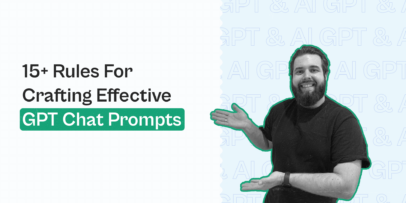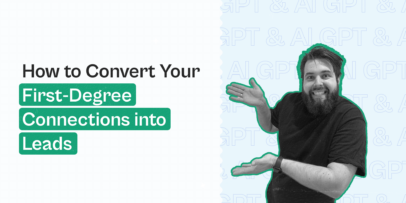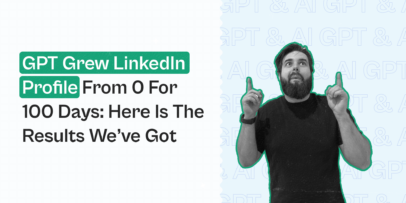Chat GPT For B2B Sales & Lead Generation: The Ultimate Guide
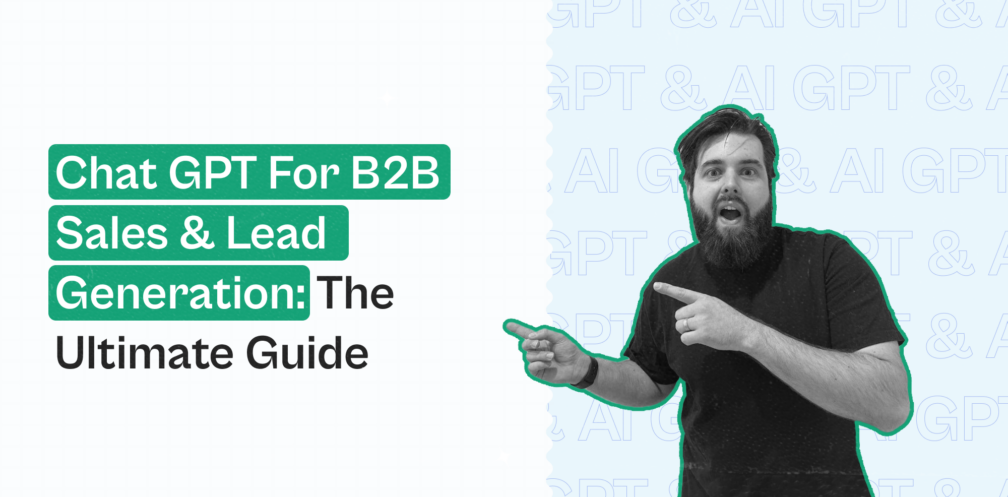
Wondering how to use ChatGPT for sales prospecting?
ChatGPT is everywhere nowadays. If anything, it’s hard to miss it no matter where you look.
And it’s true, its uses are limitless.
But one very underrated aspect of ChatGPT is using it for B2B sales and lead generation. That includes both inbound and outbound.
How, you might be wondering?
Well, with the right prompts, everything is possible. So, below, we’ll be going over how ChatGPT can work with your lead generation as well as some proven prompts to get the best output.
Here’s what we’ll cover:
- How to use ChatGPT for sales prospecting and where does the AI get its answers from?
- What are some practical use cases for using ChatGPT for B2B sales, prospecting, and marketing?
- ChatGPT lead generation overview for each stage of the outbound process.
- Chatgpt lead generation overview for each stage of the inbound process.
- 8 Tips and best practices to get the right response when using ChatGPT for B2B sales and lead generation.
If you’re interested in relevant lead generation prompts for the AI, feel free to skip ahead!

If you need more information on B2B sales and lead generation when it comes to LinkedIn in particular though, be sure to join our private Facebook group The LinkedIn Outreach Family!
What Is ChatGPT And How To Use It For Sales Prospecting
You can use ChatGPT for B2B sales, lead generation, and many other cases. The truth is, the uses are limitless, only bound by the prompts you use.
So, first, let’s take a look at how ChatGPT works in general, and then how you can use it for lead generation.
ChatGPT, as you might have heard by now, is a specialized language model developed by OpenAI based on GPT-3.5.
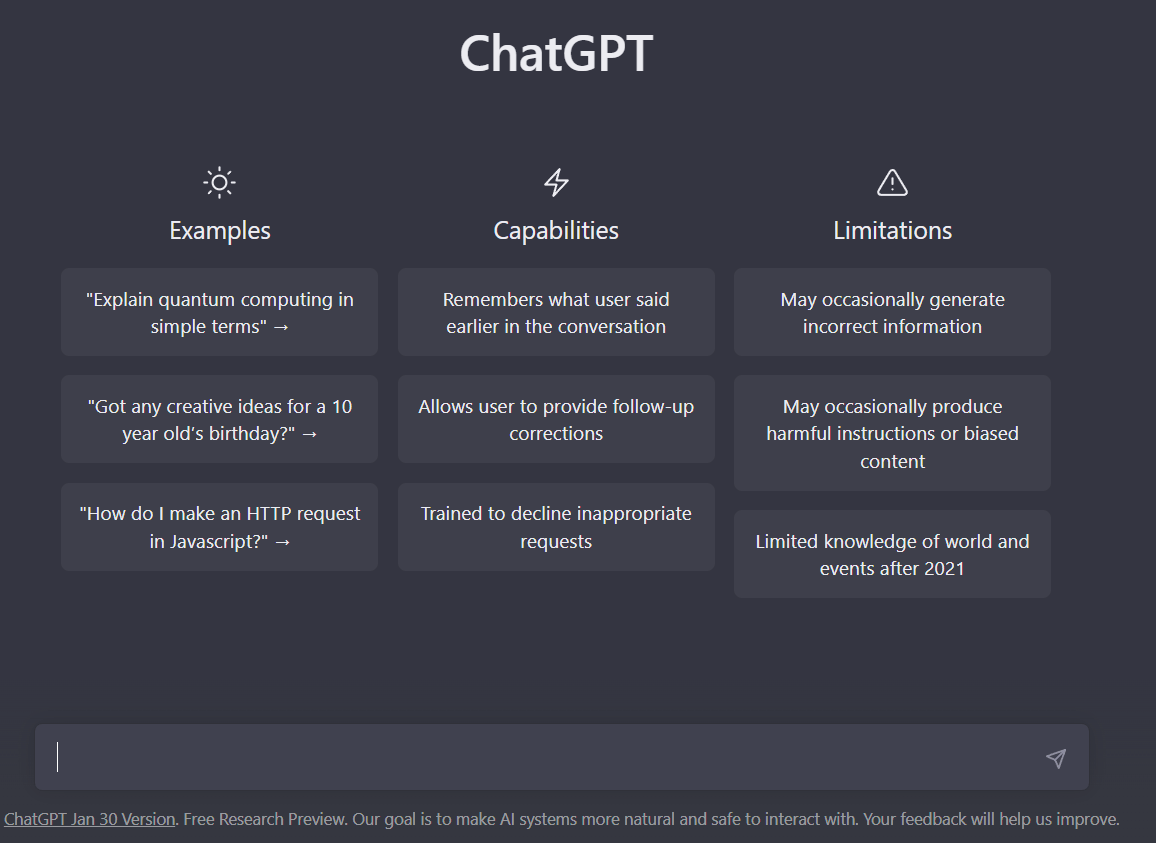
But what does this mean, exactly?
Well, here’s a quick breakdown:
- OpenAI – Artificial intelligence research and deployment company. OpenAI Inc. is the non-profit parent company of the for-profit OpenAI LP. OpenAI is also known for DALL-E, an AI system that can create realistic images and art from text description. Recently, Microsoft invested $1B in OpenAI to support building artificial general intelligence (AGI), so, we’re more likely to see OpenAI being developed further.
- GPT-3.5 – This stands for Generative Pre-trained Transformer. Without getting too techincal, it’s a neural network machine learning model trained on internet data to generate any type of text.
- GPT 4 -OpenAI’s most advanced system, producing safer and more useful responses. OpenAI describes GPT4 as “10 times more advanced than its predecessor, GPT 3.5. Essentially, this means it’s trained on more data, can handle more input and produce more output.
As of writing, ChatGPT 3.5 is free and ChatGPT 4 starts at $20/mo.
But for a more detailed breakdown, see the full ChatGPT pricing page for more info on tokens, API usage, and more.
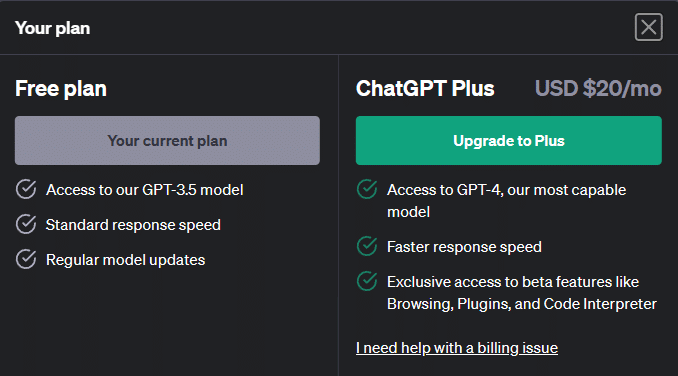
Additionally, because of the high demand, ChatGPT is often at capacity or it might lock you out if you’re using too many requests.

So, if you’re wondering whether or not you should upgrade to GPT-4 and pay the $20/mo subscription, look at it this way:
- Are you regularly hitting too many requests on the free version of ChatGPT?
- Are you using the AI for areas Google can’t help with?
- Are you planning to use ChatGPT for lead generation or for sales?
If that’s the case, yes, the $20/mo will definitely be worth the cost.
Where do ChatGPT answers come from?
Now, you might be wondering, if you’re planning to use ChatGPT for lead generation and sales, can you rely on its answers?
For that, we first need to take a look at where ChatGPT gets its answers from and how this can help you for B2B sales and lead generation.
ChatGPT was trained on massive amounts of data about code and information from the internet.
As a specialized language model, it’s designed to model the probability of sequences, typically word sequences to form coherent answers.
Then, using machine learning techniques, the AI “learns” which words are likely to follow other words.
However, one important thing to keep in mind about its accuracy is that ChatGPT finished its “training” in 2021. As a language model, it was trained on vast amount of text data, but it hasn’t been programmed to verify its accuracy or reliability.
In the tool’s own words when asked about its accuracy:

So, as a rule of thumb, if you’re asking questions based on specific information to a question that has a definitive answer, it’s always worth double-checking.
When it comes to marketing and lead generation though, ChatGPT has a lot of uses as it’s ideal for creating templates and useable text.
Especially when considering the fact that the 2021 training doesn’t affect using ChatGPT for lead generation a lot. We’ll be covering examples and details on this below. But essentially, most companies make it easy for someone (in this case the AI), to find their information and personalize their prospecting accordingly.
Additionally, we’ll be integrating ChatGPT with Google Sheets for better sales prospecting and providing company information to help the AI craft better sales messages.
Since you’re only limited by your prompts, you can get really creative and even let ChatGPT know who your target audience is. Then, to create a sales template based on that!
Let’s take a look at how this works with some examples.
How Can ChatGPT Be Used In B2B Sales, Prospecting, And Marketing?
If you’re going to be using ChatGPT for B2B sales or marketing, it’s important you’re using the right prompts.
Otherwise, most of the answers from the tool will sound like they’re from the top Google search results on the same topic. In other words, nothing new.
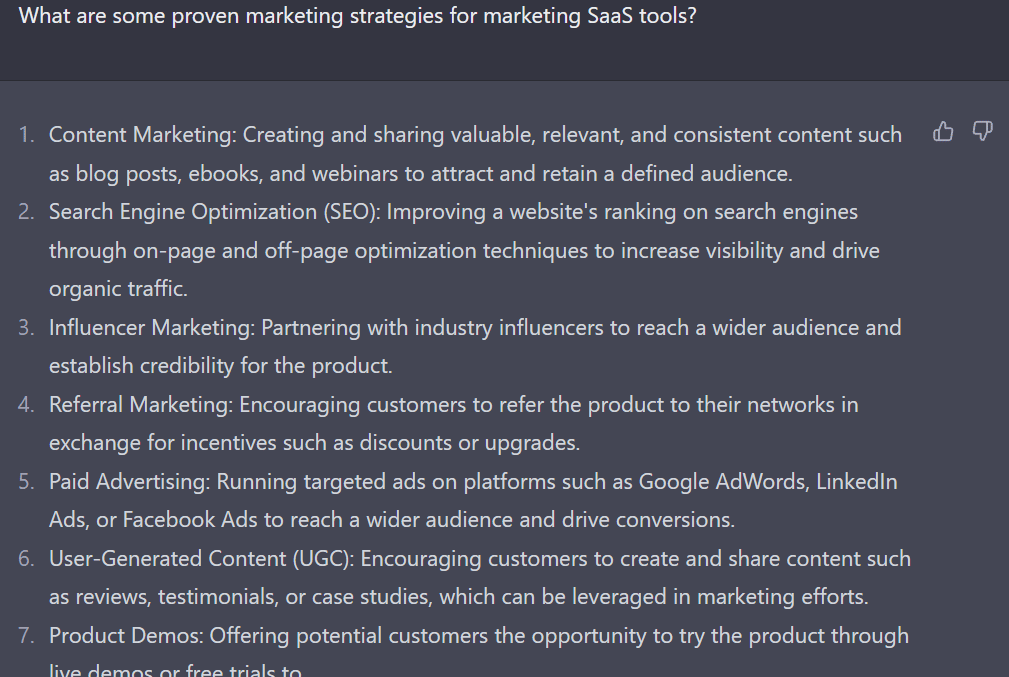
Additionally, ChatGPT is getting smarter over time.
Before, it could give faulty logic or flat-out wrong answers (e.g. “what is 2+2”), but for the most part, that doesn’t seem to be the case anymore.

Overall though, you should be using prompts that save your time or give you actionable answers.
For example, ChatGPT can’t give you the exact monthly search volume for keywords like certain B2B lead generation tools.
But it can give you a solid foundation for your SEO keyword research.
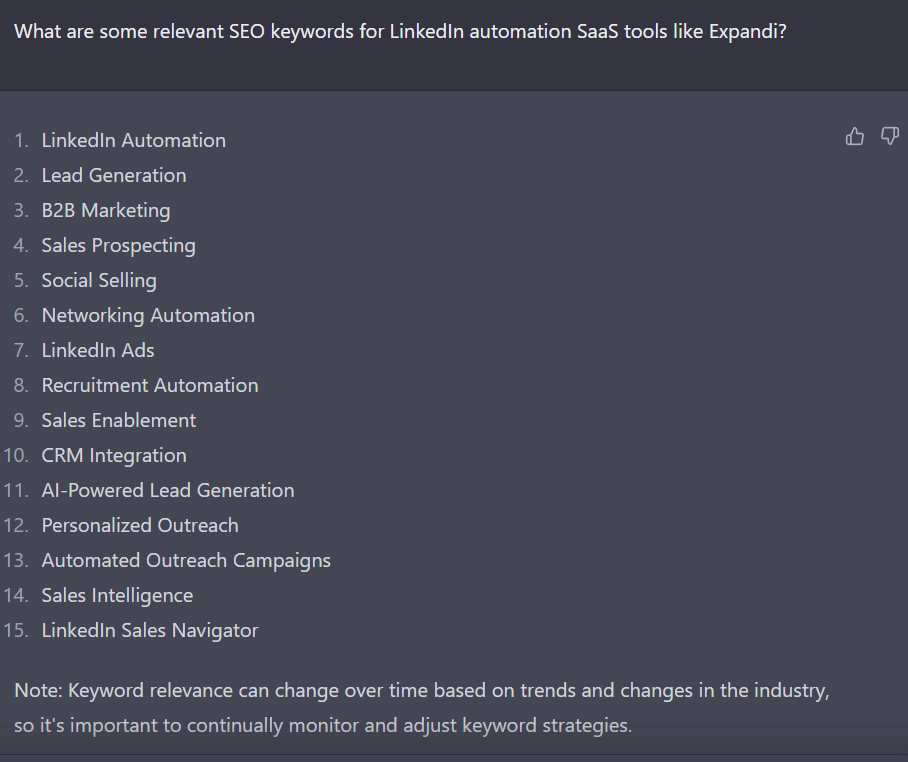
Other stages of B2B sales you can use ChatGPT in include:
- Lead generation – to generate outbound templates or text for inbound lead generation (examples below).
- Lead qualification – To qualify leads by asking targeted questions and determining the likelihood of a lead becoming a customer.
- Sales prospecting and personalization – As you’ll see below, you can use ChatGPT as a shortcut by letting it manage or manipulate your lead info. For example, you can use ChatGPT for lead generation by integrating it with your lead sheet and getting it to personalize custom text about each prospect in a new column, all automatically.
- Customer service or emails – How to answer basic customer inquiries or emails, freeing up time for your team.
- Product text – To provide text-based, step-by-step info on how to use your product, help center text, and more.
- Content creation – Whether it’s sales material, email templates, product descriptions, blog content, or something else. Though, if you’re wondering, this article was written by a human, not AI.
Below, we’re going to break this down even further by taking a look at using ChatGPT in each stage of B2B inbound and outbound lead generation.
To do this, we’ll break it down section by section based on the following sales funnel stages:
- Awareness – Lead generation stage where the goal is to generate interest in your product or service.
- Interest – Goal is to identify and quantify leads most likely to become customers.
- Decision – Persuading potential customers to make a purchase.
- Action – Closing stage where the goal is to finalize the sale and get the customer to take action.
- Retention – After the sale, when the goal is to maintain the relationship with customers and ensure their satisfaction.
For both, outbound and inbound lead generation.
Let’s take a look at outbound first.
Using ChatGPT In All Sales Funnel Stages Of Outbound Lead Generation
1. Awareness
For outbound lead generation, the awareness stage ChatGPT can help with includes:
Social selling and personal branding
Social selling is all about leveraging your network and brand to find the right prospects, build relationships, and achieve your sales goals.
The stage is crucial as it helps expand your network, build trust with your contacts, and nurture potential leads who might be interested in doing business with you.
Here, you can use ChatGPT to suggest personal branding types, what kind of content to create, and even to create the content with AI as well!
In fact, ChatGPT can be particularly useful for content creation, not just lead generation and sales.
For more info on using ChatGPT for content, see our guide on growing a new LinkedIn profile from scratch with ChatGPT.
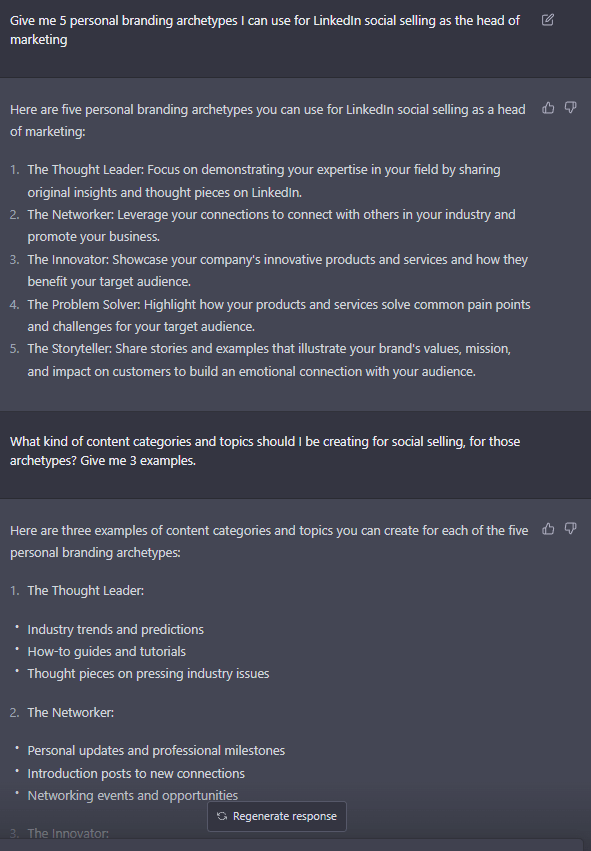
Database cleaning and list management
ChatGPT can help with preparing, updating, and managing a database in Google Sheets for outbound lead generation. Additionally, it can generate text based on specific templates and data in the spreadsheet.
However, GPT-3 cannot directly interact with Google Sheets. So, you’d need to use a third-party tool like Talarian, or have some programming or API knowledge. But for convenience’s sake, we’ll be using the Talarian extension, which works well enough for lead generation and B2B prospecting.
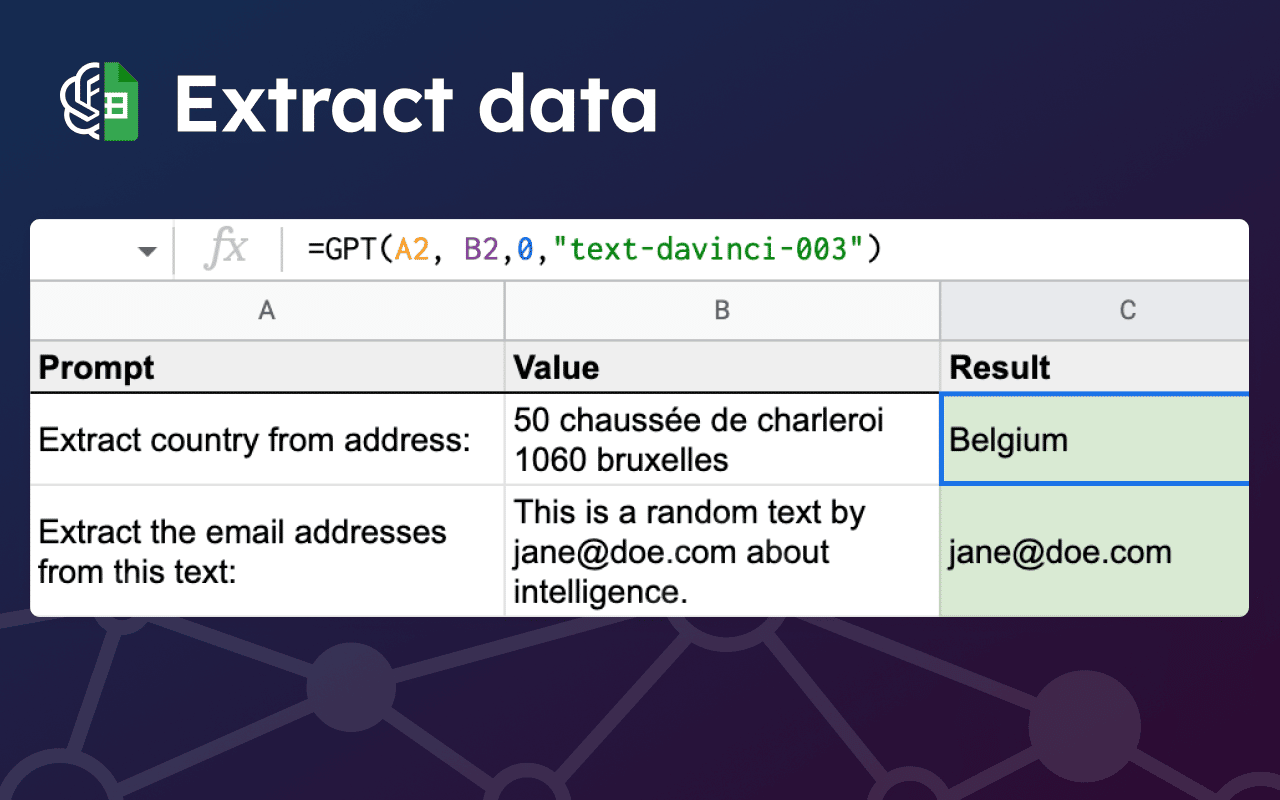
Here, with ChatGPT, you could:
- Extract certain information from different sheets (e.g. lead info).
- Classify text sentiment.
- Summarize long text automatically.
- Format or fix text.
- And more.
This can also be very useful in automatically formatting lead names when building a prospect list.

Cold emailing
When it comes to email outreach, ChatGPT can be used to:
- Generating highly personalized cold email templates.
- Generate different email subject lines.
- Write different follow up templates.
- Recommend different placeholders for personalization.
Note: ChatGPT can’t go through someone’s LinkedIn profile (for example) and give you unique text based on that.
By combining this with the above step in integrating ChatGPT with Google Sheets info, you could then use prompts such as:
Use this email opening example: “Yamini, I notice that you’ve been the CEO of HubSpot since 2021 and I wanted to reach out” to write a casual email that is 50-100 words, consider that the person we’re reaching out to is named {full_name} and they are the {title} of {company_name} since {formatted_date}. Include a 1-2 sentence case study of how we (case study example) and end with a CTA to book a 10-minute call.
You can also customize this further to your liking by modifying the prompt with additions such as:
- Do not congratulate the prospect.
- Do not say that I would love to meet them.
- Do not use jargon or buzzwords.
- Do not use a formal tone.
As an example, your Google Sheet info would look like this:

See our guide on building a prospect list if you need more help finding leads.
It’s not quite perfect but:
- It’s very impressive considering the response was generated in seconds and you can do this at scale.
- You can use different “email opening example” to craft the perfect email intro.
- The AI is bound to only get better over time.
- By playing with the prompts, you’re likely to uncover ways to improve your response.
From there, you can get a VA or an SDR to clean up the list, fix mistakes based on your checklist, or launch it as a campaign for you with your outreach tool of choice.
Considering you can do all of the above for free (with ChatGPT 3.5), this can be a huge time saver for businesses looking to automate parts of their lead generation.
Now, let’s take a look at other ways you can use chatGPT for sales.
LinkedIn outreach
Now, when it comes to LinkedIn outreach, you can use ChatGPT to:
- Generate highly-personalized and engaging messages to reach potential leads.
- Generate personalized hashtags, mentions, and call-to-actions to increase the chances of your messages being seen and read.
- Create market research for your target audience.
- And more.
What’s important here is that you properly define your buyer persona to ChatGPT. For example:
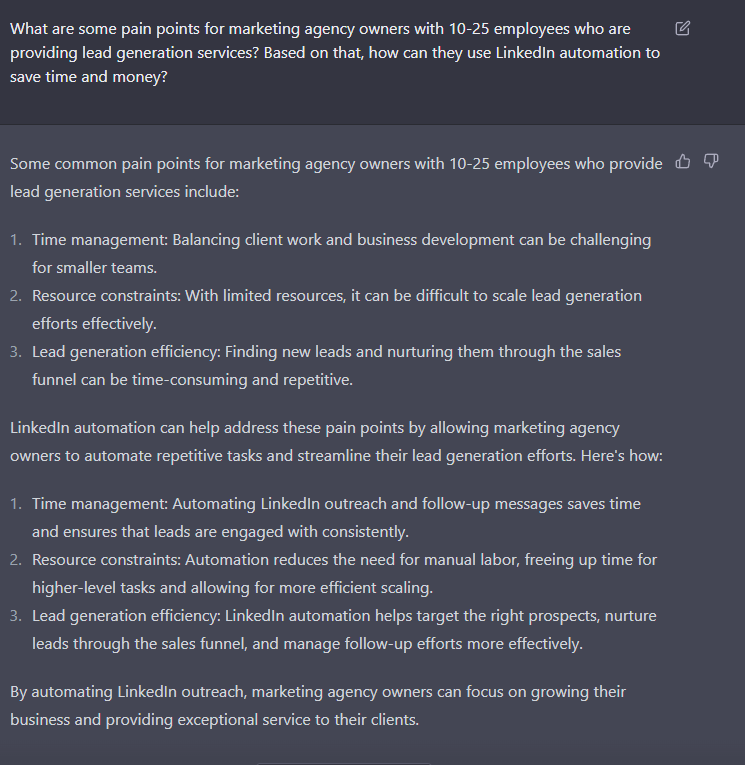
You can also experiment with different connection templates.
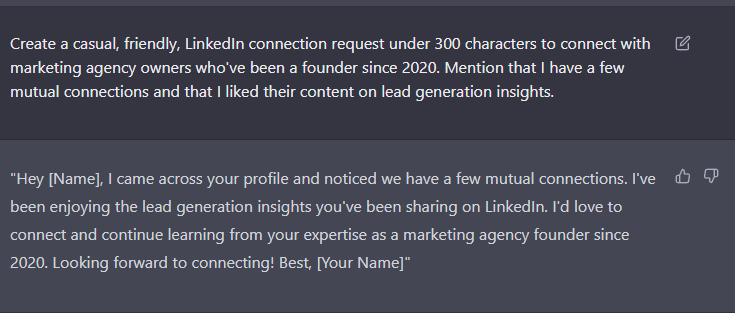
“Continue learning from your expertise as a marketing agency founder since 2020” sounds awkward. But the overall message is on the right track!
You can also integrate ChatGPT with your lead info in Google Sheets to create even more powerful outreach templates.
Essentially, you’ll need an “about prospect” column with information about each lead (e.g. from their LinkedIn profile or “about us” page). Then, you can use ChatGPT for sales prospecting by creating high-quality, personalized outreach templates based on unique lead info.
Cold calling
You can’t use ChatGPT for cold calling directly. But it can be of huge help by helping you:
- Generate highly-personalized scripts for your prospects over the phone.
- Create personalized opening lines, potential objections and how to handle them, and your closing statements based on your pitch.
- Generate answers prospects might have to potential questions based on your pitch.
- Overcome objections.
- And more.
What makes ChatGPT so powerful here is that you can add qualifiers in terms of bulletpoints to strengthen your prompt, like so:
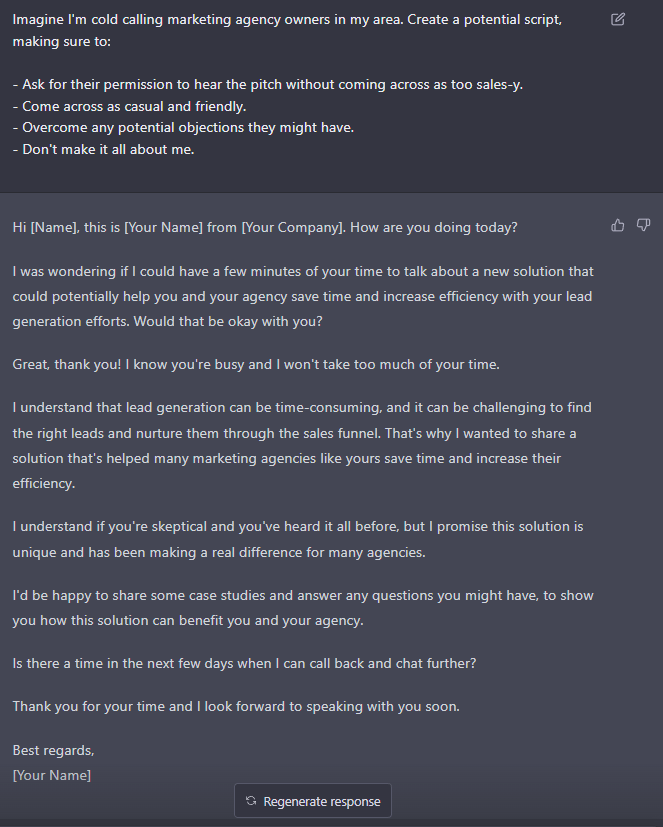
You can even create specific roleplaying scenarios by telling ChatGPT to take on the role of your prospect. Such as:
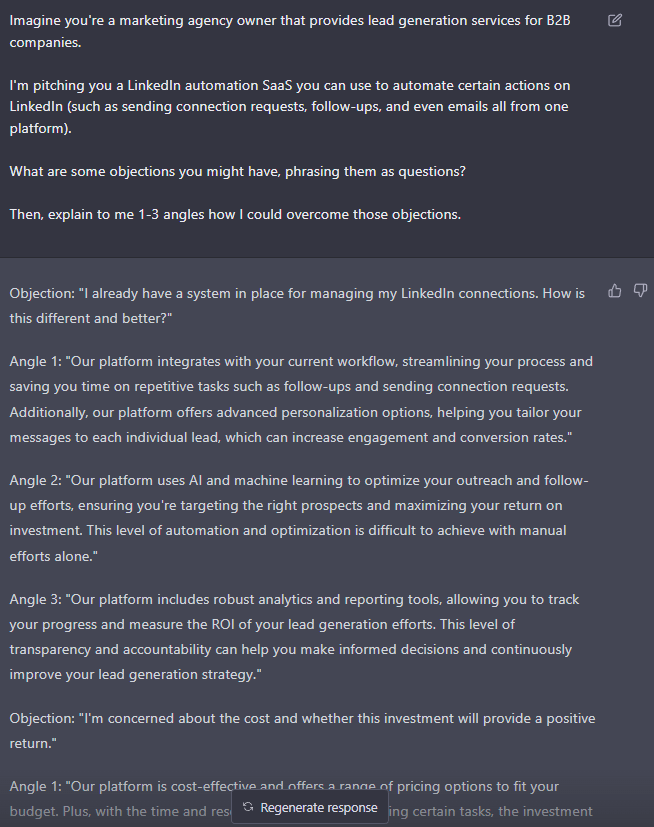
2. Interest
When it comes to qualifying leads, ChatGPT can be used to create a series of automated conversations, such as chatbots or virtual assistants. Then, you can use this to gather information about your prospect’s needs and pain points.
You can ask ChatGPT to create lead qualification questions directly, or gather information about your target market.
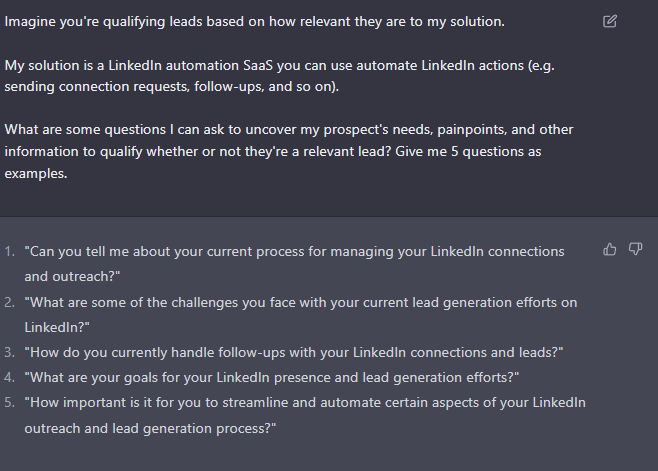
Similarly, if you integrate the AI into your outreach prospecting sheet, you can qualify or disqualify leads at scale with just a few seconds.
All you have to do is set up criteria about your ideal customer persona (e.g. agency, under 20 employees, doing outreach) and then ask ChatGPT if people inside your sheet meet that criteria or not.
Of course, you’d have to include an additional column in your prospecting sheet for each lead. But from there, all you have to do is ask ChatGPT if that unique information meets your checklist of an ideal client.
3. Decision
To persuade potential customers to make a purchase, you can use ChatGPT to:
- Create sales proposals that address specific needs and pain points.
- Create engaging sales content based on case studies, blog posts, or webinars.
- Educate potential customers about your products and services.
- And more.
What’s important to consider here is that you can “feed” ChatGPT certain information as a prerequisite, no matter how long it is. So, if you paste your case study inside the conversation section, you can tell ChatGPT to remember that information and create highly-personalized output.
Here’s an example prompt by pasting in the text from this case study and telling ChatGPT to create a sales proposal for our solution to help a marketing agency owner make a decision based on the above information.
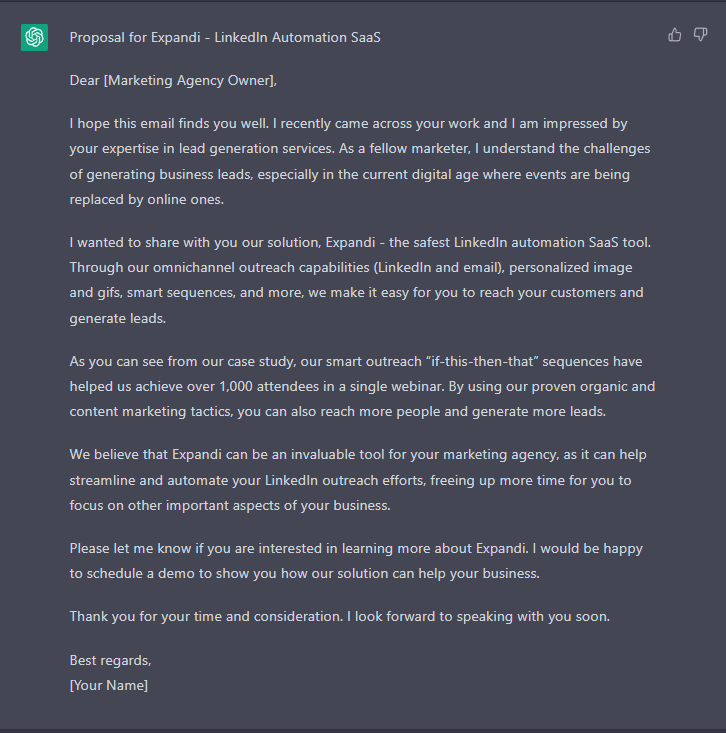
4. Action
In the closing stage, where the objective is to finalize the sale and get the customer to take action, ChatGPT can help with:
- Generating persuasive scripts.
- Emails and messages to negotiate details and close sales.
- Custom contracts and proposals templates.
- Speeding up the sales procss by coming up with a few different ways to overcome sales objections.
As with other prompts above, you can add qualifiers or certain information to make the answers highly personalized for your service (such as your company name, exact services, and so on).
This took a few minutes to generate, but for an AI working from scratch, it’s not bad!
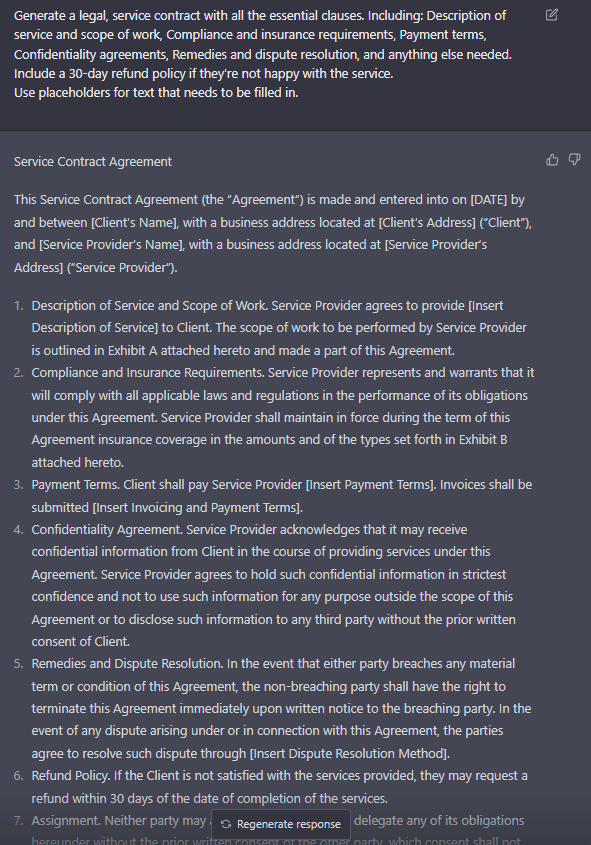
Note: While ChatGPT can generate such content, it’s always worth double checking before using any legal or Terms of Service documents. Whether it’s by you or a legal professional.
5. Retention
Last but not least, for the retention stage, ChatGPT can help with all things:
- Personalized follow-up emails.
- Questionnaire or survey newsletter emails.
- Asking for feedback.
- Creating feedback forms.
- Or gathering customer feedback in other ways to improve future sales efforts.
Here’s an example:
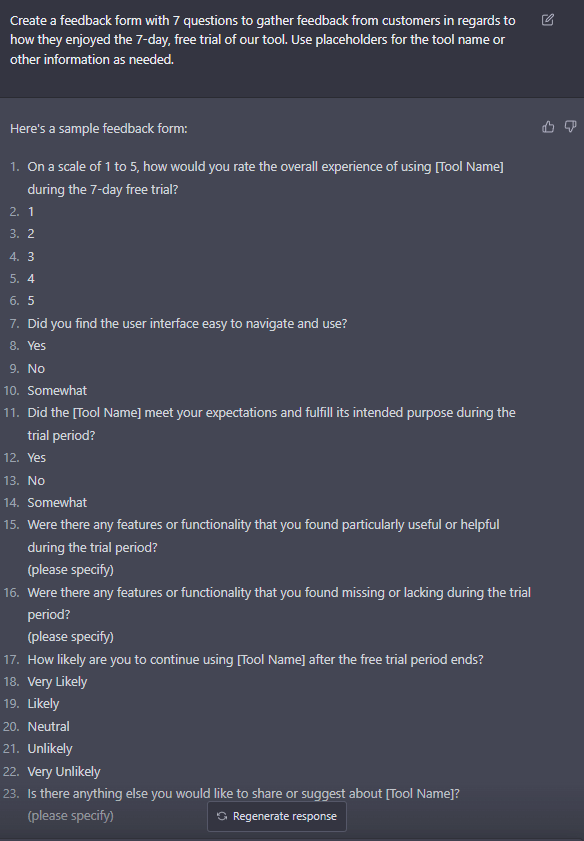
Though it messed up the formatting, you can still add more information in the prompt to improve the ChatGPT response, such as:
- Information about your solution.
- Information about your target audience.
- What they didn’t like.
- How you can improve future sales efforts.
- And more.
As you might have guessed, all this depends on using the right prompt. So that you get the most out of ChatGPT for sales and lead generation, below, we’ll cover how to create the right prompts.
But until then, let’s take a look at how to use ChatGPT for inbound lead generation.
Using ChatGPT for outbound lead generation and sales prospecting means that you can use the AI for the following stages:
- Awareness: This includes using ChatGPT for all things social selling, database cleaning and Google Sheet list management, cold emailing and LinkedIn outreach, and finally, also cold calling.
- Interest: For this stage of lead generation, you can use ChatGPT to qualify leads by creating a series of automated conversations. ChatGPT will act as your personal assistant to help you save time by gathering information about your target audience.
- Decision: Of course, ChatGPT can’t make decisions for you. But it can create sales proposals, create sales content, or educate potential customers based on their unique question, query, or background.
- Action: In this lead generation stage, ChatGPT can be useful for speeding up the sales process. It can generate persuasive scripts based on the prospect’s stage, draft up custom contracts, or help you overcome unique sales objections.
- Retention: Finally, for the retention stage, ChatGPT shines with creating feedback forms based on the customer’s stage, personalizing follow-ups based on the conversation so far, and creating newsletter email text.
It’s worth noting once again that you should always double check ChatGPT responses yourself. But in the majority cases, this is a great way to save a lot of time.
Using ChatGPT In All Sales Funnel Stages Of Inbound Lead Generation
When using ChatGPT for inbound lead generation, its main use cases have to do with creating text for different stage or marketing purposes.
This is especially useful if your skills lie somewhere else (e.g. you’re an outreach pro, but need a second pair of eyes for creating sales copy for your website).
So, when using ChatGPT for inbound lead generation, we’ll be looking at the following stages:
- Awareness.
- Interest.
- Decision.
- Action.
- Retention.
1. Awareness
One of the most common uses for ChatGPT has to do with generating interest and awareness for your brand.
Usually, this is done through:
- Creating LinkedIn content.
- Generating copy for ads.
- Writing engaging copy for your landing pages, headlines, subheadings, call-to-actions, and more.
- Lead magnets and web forms.
- Other web content such as quizzes, assessments, eBooks, and more.
When creating online content with ChatGPT, consider setting boundaries and roles so you get the best response possible.

2. Interest
To gather interest and qualify prospects, you can use ChatGPT to set up chatbot flows, conversation topics, or gather information about your target audience.
Then, you can use that information for your customer support team.
You can also do this by telling ChatGPT to act a certain role, for example:
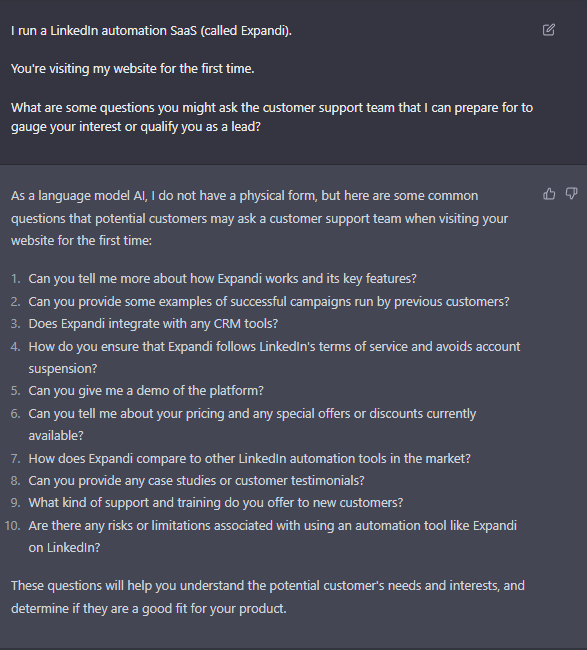
You can then create a dedicated FAQ section based on this or make sure your team knows the answers for these to prepare.
3. Decision
To help leads make better-informed decisions, you can use ChatGPT in a wide variety of ways.
One of the most common methods is for creating online text for your website. But you can also:
- Create surveys.
- Learn more information about your target market.
- Create chatbot scripts.
- Get relevant content ideas.
- Create more relevant content such as case studies, comparison pages, services pages, and more.
While it’s unlikely for ChatGPT to replace your marketing team any time soon, it can still be of great help.

You can also use ChatGPT to fully create blog posts or lead magnets such as eBooks from scratch. Though that might be more time-consuming and require more effort in your prompts.
4. Action
Finally, to help convert inbound leads into customers, you can use ChatGPT to create relevant text, landing pages, product text, and more.
Though, it’s important to take into consideration your overall inbound marketing funnel.
Because, the whole point of inbound lead generation is that prospects to come to your site and convert on their own.
Meaning, you have all the right “stops” in your funnel that help them make a more informed decision about your product or service, such as:
- Blog posts and social media that attract readers.
- Educational lead magnets based on your lead’s pain points and needs.
- Relevant copy on your landing pages and call-to-actions that convert leads into users.
- Live demos, free trials, case studies, and more.
ChatGPT can’t help with all this, since it only generates text.
But for what it’s worth, it can help improve your landing pages, copywriting, content, and more.
That said, here are some prompt examples for this stage of inbound lead generation.
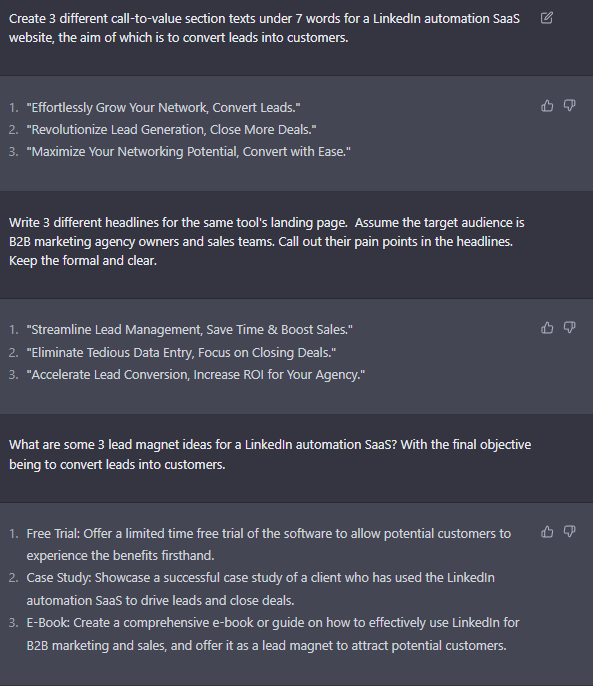
5. Retention
Last but not least, when it comes to customer retention, Chat GPT can create email campaigns to nurture leads and keep them engaged.
You can also generate a limitless number of subject lines, email body text, different call-to-action text to increase the click-through rate, and more.
Here’s a quick email marketing strategy example for SaaS from ChatGPT:
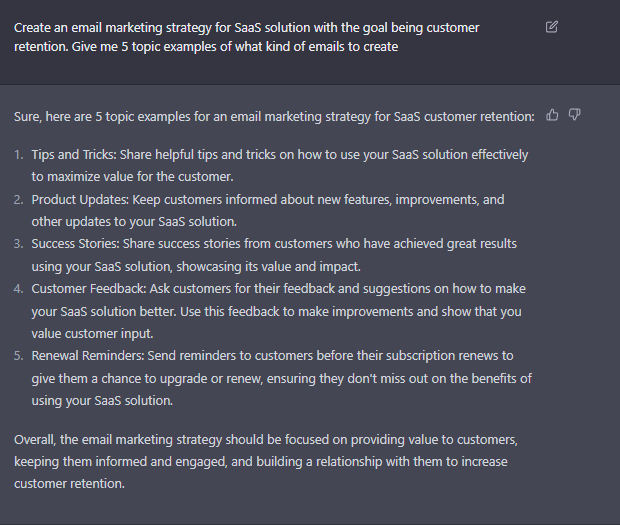
Then, we can take this a step further and generate the actual email with ChatGPT as well.
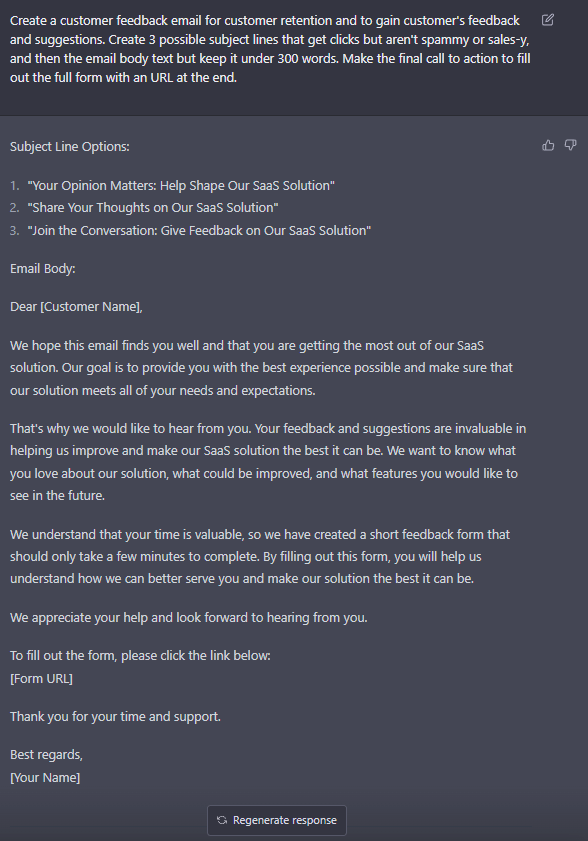
You can edit the actual response by yourself, or tell ChatGPT the following example prompts to strengthen your response:
- Make the tone more friendly and casual.
- Keep it under 200 words.
- Don’t use any buzzwords or jargon.
- Focus on what the user gets by filling in the form.
- Offer the potential to win a free 1-month trial if they fill out the form.
As you might have guessed by now, the effectiveness of the response depends entirely on your prompt.
The more conditions and specific details you include, the better your response will be.
Now, let’s recap using ChatGPT for inbound lead generation and then, take a look at some best practices to help perfect your GPT prompts. Whether you’re using ChatGPT for sales, lead generation, or prospecting.
- Awareness: This is one of the most common use cases for ChatGPT. Depending on your obejctive, you can get the AI to help you create LinkedIn content, sales text with your tone of voice for your ads, lead magnets, or just plain blog posts.
- Interest: For this stage of inbound lead generation, you can use ChatGPT to gather interest, qualify prospects, or learn more about your prospects to see if they match your ideal customer persona.
- Decision: To help you make better-informed decisions about your leads, you can use ChatGPT to help you narrow down prospects in a variety of ways. For example, you can create surveys, learn more about your target market, get relevant content ideas, and more.
- Action: This is probably the most important lead generation stage as you’ll want to convert leads into paying customers. With this, ChatGPT can act as your personal copywriter and create relevant sales text, landing page, product text, and more.
- Retention: Finally, when it comes to customer retention, ChatGPT can help you create personalized email campaigns to nurture your leads and keep them engaged.
Pro tip: If you’re planning to use ChatGPT for your inbound lead generation or writing a lot, we strongly recommend paying for ChatGPT 4 ($20/mo). Writing is one of the many upgrades you see with the premium version of AI.
8 Tips And Best Practices To Create The Right ChatGPT Prompts For B2B Sales And Lead Generation
Finally, to make you’re generating high-quality ChatGPT responses, here are some tips and best practices you should be following when using the tool.
- Be clear and specific – Clearly state your task or questions. The more specific the prompt, the more accurate the response will be. E.g. “Create a cold outreach email that generates leads” vs “Create a cold outreach email under 200 words with a friendly, casual tone that targets SaaS tool owners, with the purpose being to book a quick, 5-minute call. Include pain points sales teams might have.”
- Provide context – Make sure you provide any background information to help ChatGPT understand the task or question. This might include what your or your company does, who your target audience is, what the length of the response should be, and so on.
- Use the right language and terminology – As an AI, ChatGPT is not all-knowing. Or it might not know the exact language your target audience speaks in, down to the phrases. So, if you work in a specific industry, be sure to include that in the prompt. Alternatively, you can include in the prompt to not use any jargon or vague language.
- Be concise – ChatGPT can understand long prompts, but it’s easy to include a lot of unnecessary information. Keep your prompts short and straight to the point.
- Include any necessary constraints – If there are any specific constraints or guidelines that the generated response must follow, be sure to include them in the prompt. For lead generation, for example, this can include the tone, the length, the target audience, and so on.
- Provide examples – To help ChatGPT understand what you’re looking for, provide examples of what kind of text you’re looking for. This can include specific language (e.g. “LinkedIn post under 300 words”) or text “model” the response on (e.g. “Create an article under 1,500 words based on the following key information…”
- Include roles – You can get ChatGPT to act as a member of your target audience. This can be useful for generating objections or potential questions that might come up in sales calls. Alternatively, you can tell the AI to “stay in character” and come back to the conversation any time you need to do more research
- Test and adjust – Finally, to get better at ChatGPT, you’ll need to constantly test the prompt and adjust it as necessary. This varies prompt-to-prompt, so, you’ll have to play with it to get it right.
The structure for getting useful ChatGPT prompts is:
- “I want you to act as ___ for ___”
- “Your task is to ___”
- “___ should ___”
- “___ should not ___”
- “To get started, please ___”
- “Assuming I am ___, what would be the best way to ___”
- “Your job is to ____, I want you to___”
And finally when using ChatGPT for lead generation, it’s important you also keep in mind:
- It’s a machine learning model – So, the quality of the output will depend on the data it’s been trained on.
- The tool is constantly being worked on – Expect to see more changes or features in the future. It also might become monetized at some point.
Conclusion
Hopefully, you have a better idea of how to use ChatGPT for lead generation now.
That said, there are certain things the AI can’t do, such as:
- It doesn’t have access to the internet or external information as it provides info only on what it’s been trained on.
- Give information on anything that might be illegal or against its terms of service.
- Give up-to-date information.
- Accept other modes of input other than text.
But if you ARE planning to use it for lead generation, it’s going to be extremely useful for generating content, templates, responses, emails, and more.
Combined with Expandi, you can create automated LinkedIn campaigns with AI-generated text almost instantly. And start seeing results within 24 hours!
Learn how and get started with a free, 7-day Expandi trial now! Or check out the live demo here!
Or, if you need more information on LinkedIn lead generation in particular, be sure to join our private group The LinkedIn Outreach Family.
You’ve made it all the way down here, take the final step
